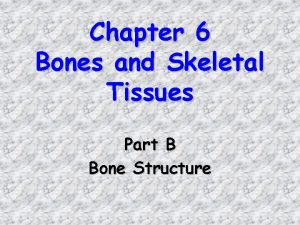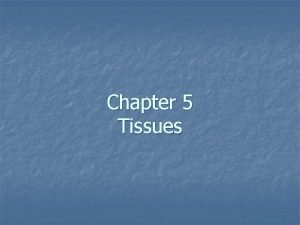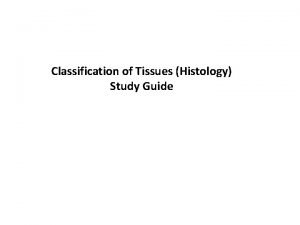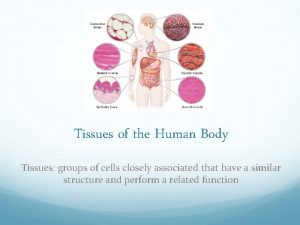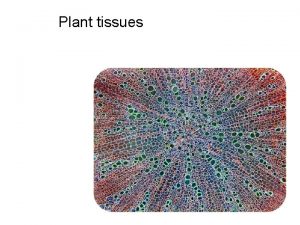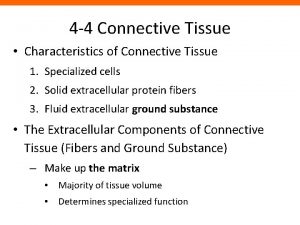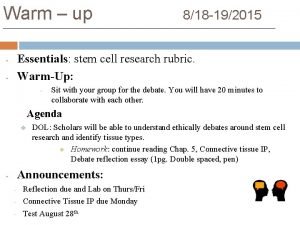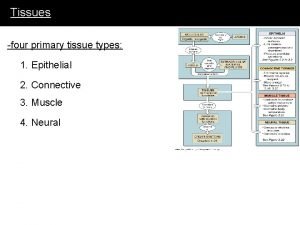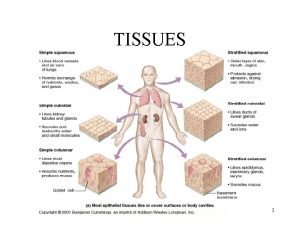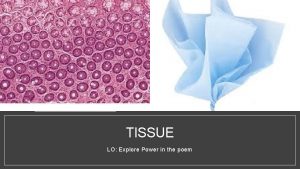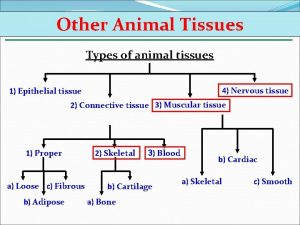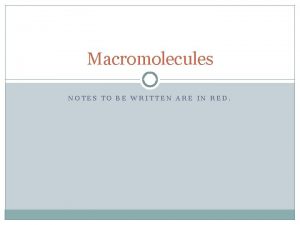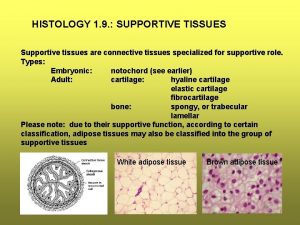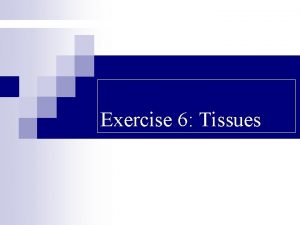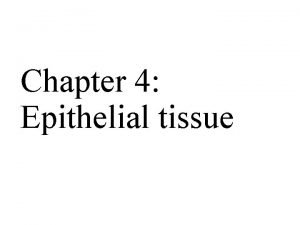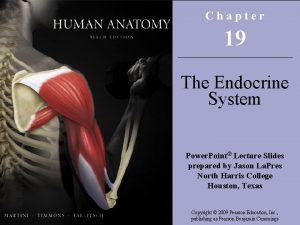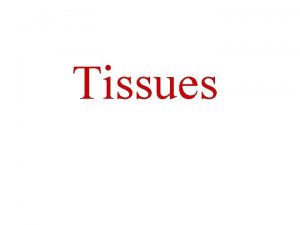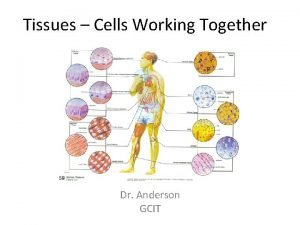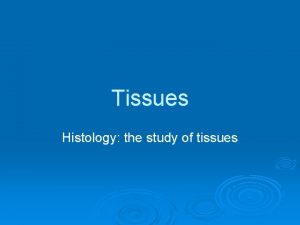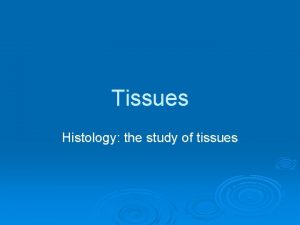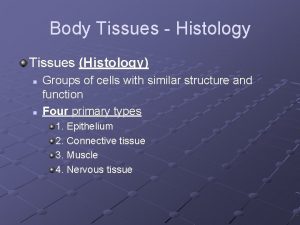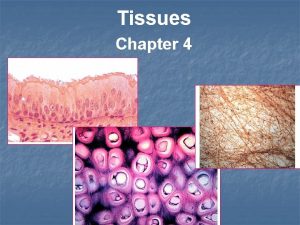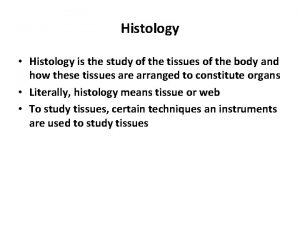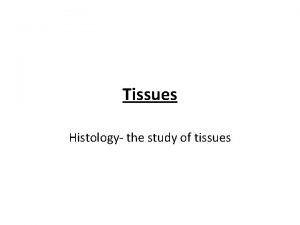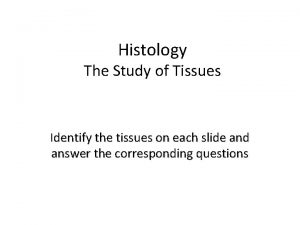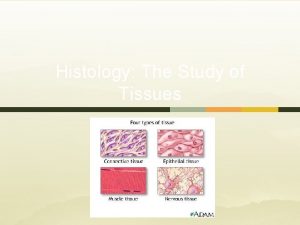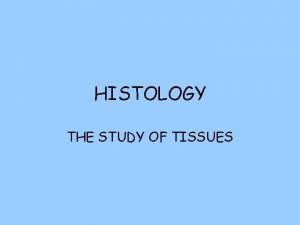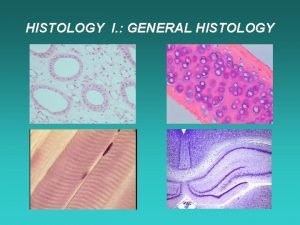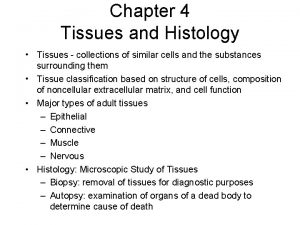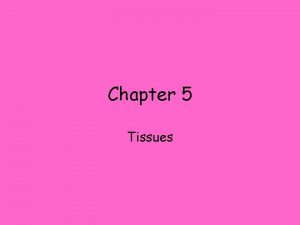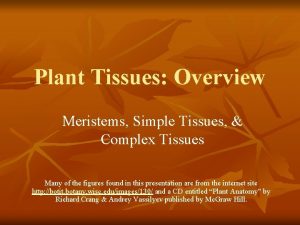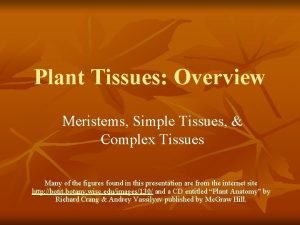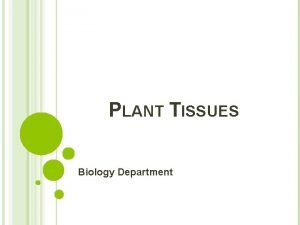Chapter 3 Histology The Study of Tissues Dr






































- Slides: 38

Chapter 3 Histology: The Study of Tissues Dr. Duran Kala

Tissues and Histology • What is a Tissue? – A collection of similar cells and noncellular substances (extracellular matrix) secreted by the cells • Tissue Level of Organization – – Epithelial Connective Muscle Nervous • Histology: Microscopic Study of Tissues 4 -2

Main characteristics of the four basic types of tissues. Tissues Cells Extra cellular Main matrix functions Epithelial Accumulated polyhedral cells Small amount Connective Several types of Abundant fixed and amount wandering cells Support and protection Muscle Elongated contractile cells Moderate amount Movement Nervous elongated None Transmission of nervous impulses Lining of surface or body cavities, glandular secretion 4 -3

1. EPITHELIAL TISSUE • Epithelial tissues form boundaries between environments. • Epithelia are thus made of sheets of tightly connected cells. • Types: – Covering & lining epithelium. • Outer layers of skin. • Linings of cavities. – Glandular epithelium. • Glands 4 -4

Epithelium Characteristics 1. Consists almost entirely of cells 2. Covers body surfaces and forms glands 3. Has free and basal surface 4. Avascular 5. Undergoes mitosis Fig. 4. 1 6. Regenerative. 7. Limited – layer or layers 4 -5

ROLE OF EPITHELIA • Protection. – Skin • Absorption. – GI • Filtration. – Kidney • Secretion. – Glands • Sensory Perception. – Skin, GI 4 -6

Classification of Epithelium: How to Make Sense of It All? There are 2 basic features (or criteria) for classification of epithelium: 1. Number of cell layers • • Simple – Single layer Stratified – More than 1 layer Exceptions? • • Pseudostratified – Single layer; only some cells reach free surface Transitional – Number of cell layers decreases as it is stretched Fig. 4. 2 4 -7

Classification of Epithelium 2. Shape of cells • Squamous (=scaly) – • Cuboidal – • Cells flattened Cells cube-shaped Columnar – Cells are taller than wide Fig. 4. 2 4 -8

Types of Epithelial Tissues • Simple squamous: Lining of vessels (endothelium). Serous lining of cavities; pericardium, pleura, peritoneum (mesothelium). • Functions: Facilitates the movement of the viscera (mesothelium), active transport by pinocytosis (mesothelium and endothelium), secretion of biologically active molecules (mesothelium) • Cell shapes are polygonal. 4 -9

Types of Epithelial Tissues • Simple cuboidal: Covering the ovary, thyroid. • Functions: Covering, secretion. 4 -10

Types of Epithelial Tissues • Simple columnar: Lining of intestine, gallbladder • Functions: Protection, lubrication, absorption, secretion. • In the small intestine the apical surface of these cells have microvilli present on their surface and specialized gland cells called goblet cells which produce and secrete mucus. microvilli on apical surface 4 -11

Types of Epithelial Tissues • Pseudostratified columnar ciliated: layers of cells with nuclei at different levels; not all cells reach surface but all adhere to basal lamina. • Lining of trachea, bronchi, nasal cavity, and lining of the Fallopian tubes (oviducts) of female. • Functions: Protection, secretion; cilia-mediated transport of particles trapped in mucus out of the air passages. 4 -12

Types of Epithelial Tissues • Stratified squamous epithelial non-keratinized (moist) lining of Mouth, esophagus, larynx, vagina, anal canal. • Funtions: Protection, secretion; prevents water loss. • Cells can be cuboidal or columnar over the basal lamina but they are flattened near the surfaces. 4 -13

Types of Epithelial Tissues • Stratified squamous epthithelium keratinized(dry) : • Location: Epidermis. • Function: Protection; prevents water loss. • Keratin is a layer a waterproof protein on the apical surface of stratified squamous keratinized epithelium (skin). 4 -14

4 -15

Stratified Cuboidal Epithelium • Sweat glands, developing ovarian follicles. • Protection, Secretes sweat; ovarian hormones & produces sperm 4 -16

Stratified columnar epithelium Multiple layers of cells in which the surface layer is cuboidal or columnar. Function: Protection or secretion. Location: Conjunctiva (mucus membrane on the eyeball and eyelids) 4 -17 , Male Urethra, Sweat Glands

Types of Epithelial Tissues • Stratified Transitional: This epithelium is unique to the urinary bladder, ureters and renal calces. • Functions: Protection, expandability. • It has the unique property of expansion and contraction. This allows the tissue to adjust to the urinary bladder’s expansion and contraction when it is full or empty. 4 -18

Glands • • Secretory organs made mostly of epithelium Form as invaginations (ingrowths) of outer layer of epithelium in embryo • Two basic types: 1. Exocrine: – Have ducts lined with epithelium – Salivary glands, sweat glands, mucus gland 2. Endocrine: – Have no ducts – Examples include pituitary gland, pancreas, thyroid gland 4 -19

Epithelial Cell Junctions 4 -20

Junctional Complexes 4 -21

Tight Junctions by TEM 4 -22

Tight Junctions by Freeze Fracture 4 -23

Tight Junction diagram 4 -24

Gap Junction by TEM 4 -25

Gap Junction 2 n. M gap between membranes Open pores for ions, molecules, etc Connexin molecules 4 -26

TEM of Zonula Adherens (red arrows) TEM of a Desmosome (blue arrow) 4 -27

TEM (colorized) of Adherens Junctions 4 -28

TEM of a Desmosome with tonofibrils 4 -29

Desmosome Structure 4 -30

The macromolecular components of basal laminae • Laminin ( large glycoprotein molecules), • Type IV collagen(monomers of type IV collagen contain three polypeptide chains ) • Entactin, (a glycoprotein) • Perlecan, a proteoglycan (mucopolysaccharide that containing polysaccharide and amino acid) with heparan sulfate side chains. These glycosylated proteins and others serve to link together the laminin and type IV collagen sheets. 4 -31

Specializations of Cell Surface • Microvilli – Found mainly on absorptive cells – Brush border, 1 m high • Cilia / flagella – Cylindrical, motile structures, 5 -10 m high – Contain microtubules – Basal bodies Sterocilia: arelong apical processes of cells in other absorptive epithelia such as that lining the epididymis and ductus deferens. These structures are much longer and less motile than microvilli 4 -32

Microvilli Apical region of an intestinal epithelial cell seen with TEM. Filaments that constitute the core of the microvilli are clearly seen. An extracellular cell coat (glycocalyx) is bound to the plasmalemma of the microvilli. 4 -33 x 45, 000.

4 -34

Stereocilia 4 -35

Cilia 4 -36

MEDICAL APPLICATION • Both benign and malignant tumors can arise from most types of epithelial cells. • Carcinoma (Gr. karkinos, cancer, + oma, tumor) is a malignant tumor of epithelial cell origin • Malignant tumors derived from glandular epithelial tissue are usually called adenocarcinomas (Gr. adenos, gland, + karkinos); these are by far the most common tumors in adults. • Under certain abnormal conditions, one type of epithelial tissue may undergo transformation into another type in another reversible process called metaplasia. Examples are 1 -In heavy cigarette smokers, the ciliated pseudo-stratified epithelium lining the bronchi can be transformed into stratified squamous epithelium. 2 -In individuals with chronic vitamin A deficiency, epithelial tissues of the type found in the bronchi and urinary bladder are gradually replaced by stratified squamous epithelium 4 -37

4 -38
 Body tissues chapter 3 cells and tissues
Body tissues chapter 3 cells and tissues 4 body tissues
4 body tissues Body tissues chapter 3 cells and tissues
Body tissues chapter 3 cells and tissues Body tissues chapter 3 cells and tissues
Body tissues chapter 3 cells and tissues Cells form tissues. tissues form __________.
Cells form tissues. tissues form __________. Chapter 6 bones and skeletal tissues
Chapter 6 bones and skeletal tissues Which part of the cell contains genetic material
Which part of the cell contains genetic material Cell membrane phospholipids
Cell membrane phospholipids Four principal types of tissue
Four principal types of tissue Smooth endoplasmic
Smooth endoplasmic Simple squamos
Simple squamos Chapter 8 oral embryology and histology
Chapter 8 oral embryology and histology Special connective tissue
Special connective tissue Tissue types in the body
Tissue types in the body Helianthus stem
Helianthus stem 3 tissues of a plant
3 tissues of a plant Plant tissue and organs
Plant tissue and organs Jane campion tissues
Jane campion tissues Mesophyll function
Mesophyll function Tissues causes of civil war
Tissues causes of civil war Four basic tissues
Four basic tissues Characteristics of connective tissues
Characteristics of connective tissues Tissues are groups of similar cells working together to
Tissues are groups of similar cells working together to Genetic effects on gene expression across human tissues
Genetic effects on gene expression across human tissues Types of cells in areolar tissue
Types of cells in areolar tissue Types of tissues
Types of tissues Four primary tissue types
Four primary tissue types Tissues are groups of similar cells working together to
Tissues are groups of similar cells working together to Poem about tissues
Poem about tissues Types of tissues
Types of tissues What macromolecule is a prominent part of animal tissues
What macromolecule is a prominent part of animal tissues Where are loins on a human
Where are loins on a human What are supportive tissues
What are supportive tissues What is this tissue
What is this tissue Identify connective tissue quiz
Identify connective tissue quiz Tissue type
Tissue type Endocrine tissues
Endocrine tissues 4 major tissues
4 major tissues Tissues working together
Tissues working together





